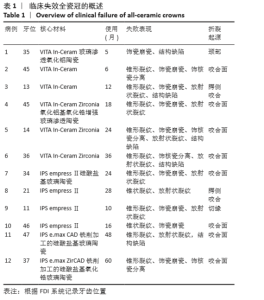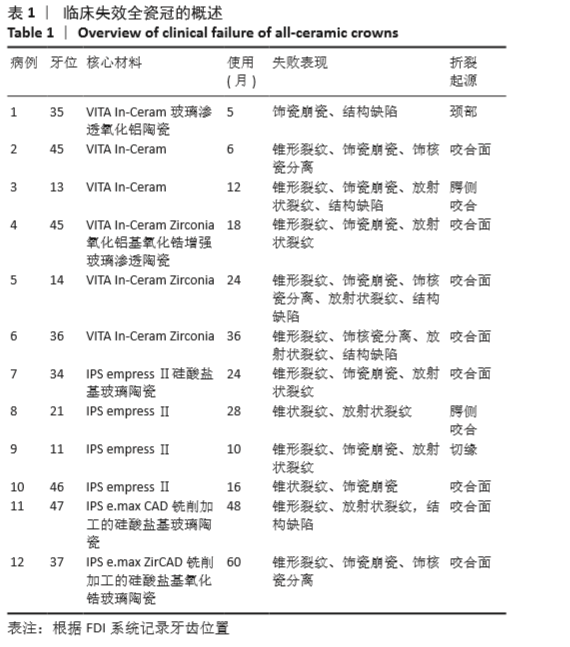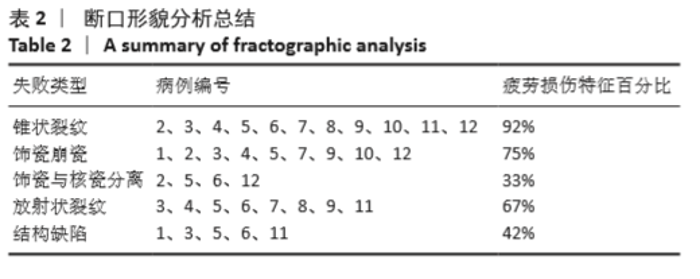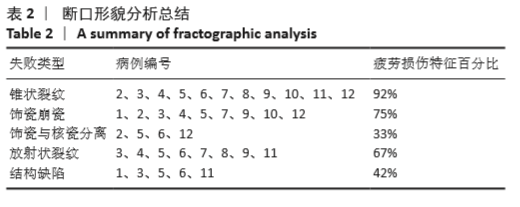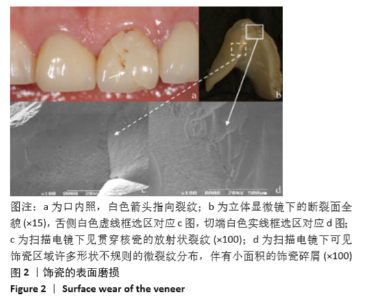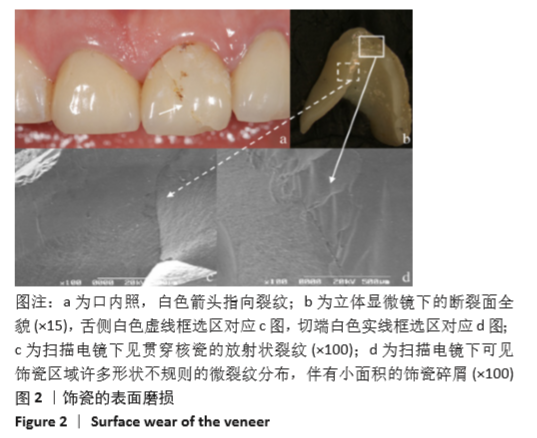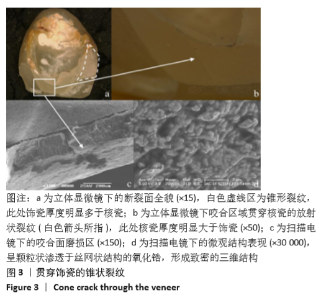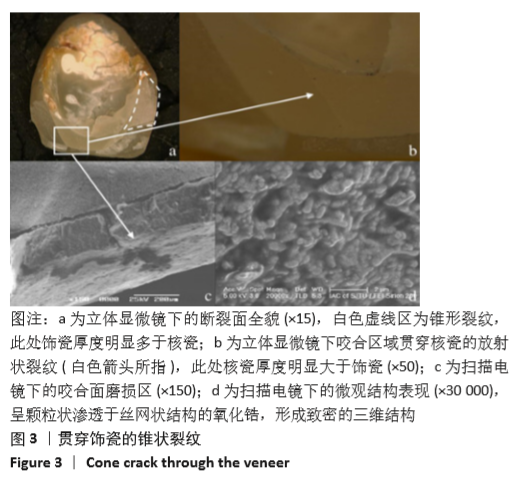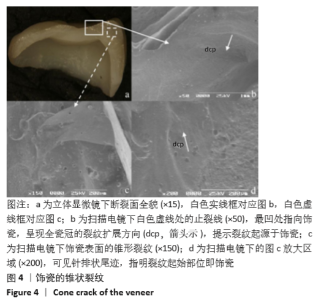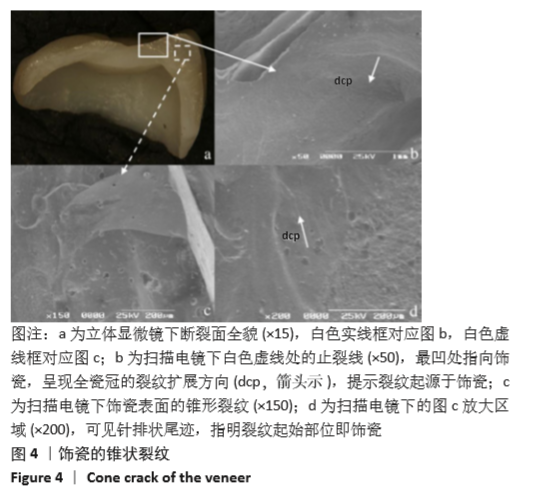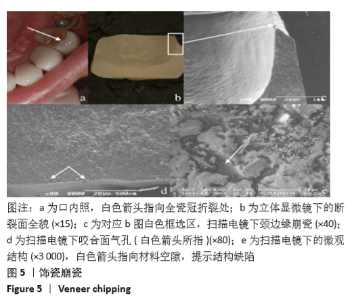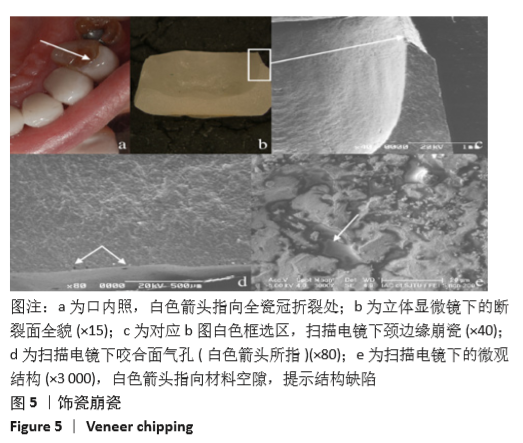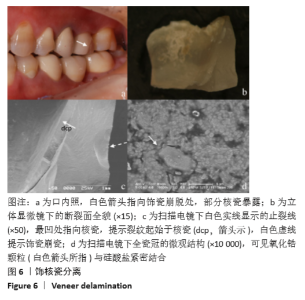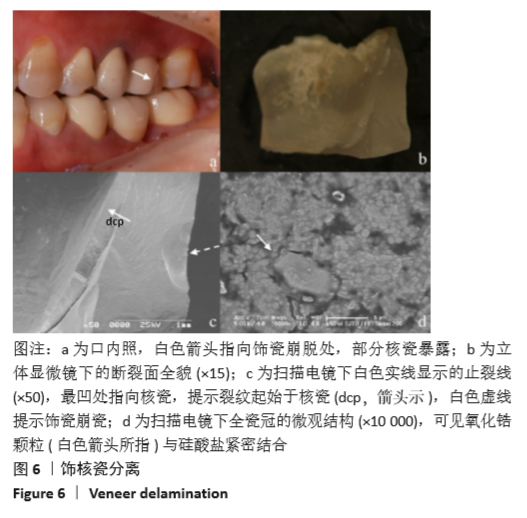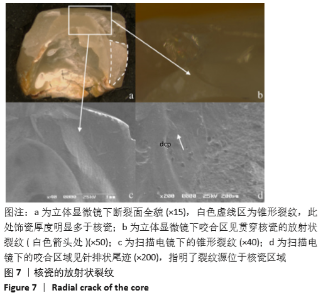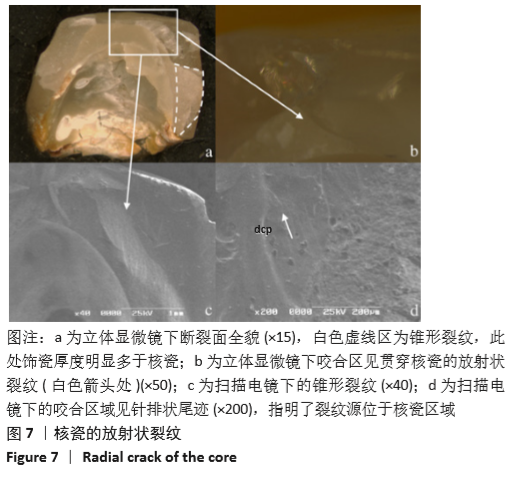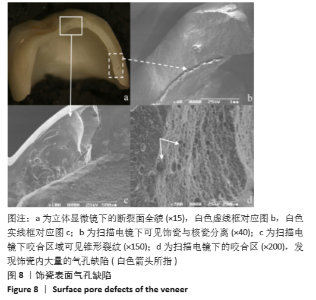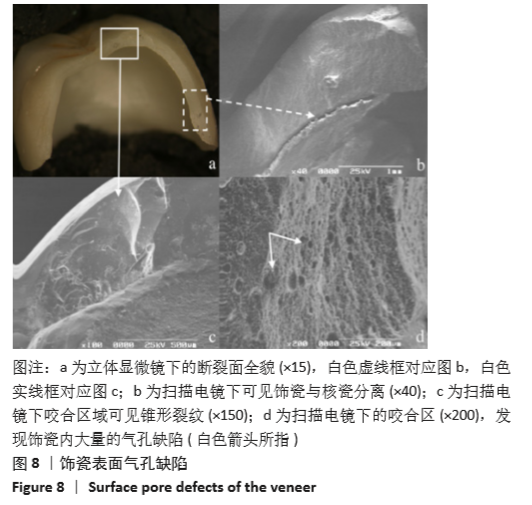Chinese Journal of Tissue Engineering Research ›› 2021, Vol. 25 ›› Issue (28): 4504-4509.doi: 10.12307/2021.065
Previous Articles Next Articles
Fractographic analysis on fracture failure behavior of all-ceramic crowns
Bao Xinlian, Su Yi
- Department of Stomatology, Eye & ENT Hospital of Fudan University, Shanghai 200031, China
-
Received:2020-07-16Revised:2020-07-21Accepted:2020-08-19Online:2021-10-08Published:2021-05-20 -
Contact:Su Yi, Associate chief physician, Department of Stomatology, Eye & ENT Hospital of Fudan University, Shanghai 200031, China -
About author:Bao Xinlian, Master, Physician, Department of Stomatology, Eye & ENT Hospital of Fudan University, Shanghai 200031, China
CLC Number:
Cite this article
Bao Xinlian, Su Yi. Fractographic analysis on fracture failure behavior of all-ceramic crowns[J]. Chinese Journal of Tissue Engineering Research, 2021, 25(28): 4504-4509.
share this article
Add to citation manager EndNote|Reference Manager|ProCite|BibTeX|RefWorks
| [1] ZARONE F, DI MAURO MI, AUSIELLO P, et al. Current status on lithium disilicate and zirconia: a narrative review. BMC oral health. 2019;19(1): 114-134. [2] SAILER I, MAKAROV NA, THOMA DS, et al. All-ceramic or metal-ceramic tooth-supported fixed dental prostheses (FDPs)? A systematic review of the survival and complication rates. Part I: Single crowns (SCs). Dent Mater. 2015;31(6):603-623. [3] LOHBAUER U, SCHERRER SS, DELLA BONA A, et al. ADM guidance-Ceramics: all-ceramic multilayer interfaces in dentistry. Dent Mater. 2017;33(6):585-598. [4] KELLY JR, CESAR PF, SCHERRER SS, et al. ADM guidance-ceramics: Fatigue principles and testing. Dent Mater. 2017;33(11):1192-1204. [5] WENDLER M, BELLI R, VALLADARES D, et al. Chairside CAD/CAM materials. Part 3: Cyclic fatigue parameters and lifetime predictions. Dent Mater. 2018;34(6):910-921. [6] ØILO M, HARDANG AD, ULSUND AH, et al. Fractographic features of glass-ceramic and zirconia-based dental restorations fractured during clinical function. Eur J Oral Sci. 2014;122(3):238-244. [7] DENG Y, LAWN BR, LLOYD IK. Characterization of damage modes in dental ceramic bilayer structures. J Biomed Mater Res. 2002;63(2): 137-145. [8] QUINN GD. Fractography of Ceramics and Glasses. http://dx.doi.org/10.6028/NIST.SP.960-16e2,2016. [9] FERRUZZI F, FERRAIRO BM, PIRAS FF, et al. Fatigue survival and damage modes of lithium disilicate and resin nanoceramic crowns. J Appl Oral Sci. 2019;27:e20180297. [10] WAKABAYASHI N, ANUSAVICE KJ. Crack Initiation Modes in Bilayered Alumina/Porcelain Disks as a Function of Core/Veneer Thickness Ratio and Supporting Substrate Stiffness. J Dent Res. 2016;79(6):1398-1404. [11] NAWAFLEH NA, HATAMLEH MM, ÖCHSNER A, et al. Fracture load and survival of anatomically representative monolithic lithium disilicate crowns with reduced tooth preparation and ceramic thickness. J Adv Prosthodont. 2017;9(6):416. [12] NAWAFLEH N, HATAMLEH MM, OCHSNER A, et al. The Impact of Core/Veneer Thickness Ratio and Cyclic Loading on Fracture Resistance of Lithium Disilicate Crown. J Prosthodont. 2018;27(1):75-82. [13] FIGUEIREDO VMGD, PEREIRA SMB, BRESSIANI E, et al. Effects of porcelain thickness on the flexural strength and crack propagation in a bilayered zirconia system. J Appl Oral Sci. 2017;25(5):566-574. [14] FLEMING G, DICKENS M, THOMAS L, et al. The in vitro failure of all-ceramic crowns and the connector area of fixed partial dentures using bilayered ceramic specimens: The influence of core to dentin thickness ratio. Dent Mater. 2006;22(8):771-777. [15] KIM J, DHITAL S, ZHIVAGO P, et al. Viscoelastic finite element analysis of residual stresses in porcelain-veneered zirconia dental crowns. J Mech Behav Biomed Mater. 2018;82:202-209. [16] ZHANG Z, ZHOU S, LI Q, et al. Sensitivity analysis of bi-layered ceramic dental restorations. Dent Mater. 2012;28(2):e6-e14. [17] WENDLER M, BELLI R, LOHBAUER U. Factors influencing development of residual stresses during crystallization firing in a novel lithium silicate glass-ceramic. Dent Mater. 2019;35(6):871-882. [18] LOHBAUER U, WENDLER M, RAPP D, et al. Fractographic analysis of lithium silicate crown failures during sintering. SAGE Open Med Case Rep. 2019;7:1983896X-2050313X. [19] SCHERRER SS, LOHBAUER U, DELLA BONA A, et al. ADM guidance—Ceramics: guidance to the use of fractography in failure analysis of brittle materials. Dent Mater. 2017;33(6):599-620. [20] PANG Z, CHUGHTAI A, SAILER I, et al. A fractographic study of clinically retrieved zirconia–ceramic and metal–ceramic fixed dental prostheses. Dent Mater. 2015;31(10):1198-1206. [21] ØILO M, QUINN GD. Fracture origins in twenty-two dental alumina crowns. J Mech Behav Biomed Mater. 2016;53:93-103. [22] MORAGUEZ OD, WISKOTT HW, SCHERRER SS. Three- to nine-year survival estimates and fracture mechanisms of zirconia- and alumina-based restorations using standardized criteria to distinguish the severity of ceramic fractures. Clin Oral Investig. 2015;19(9):2295-2307. [23] KRUMMEL A, GARLING A, SASSE M, et al. Influence of bonding surface and bonding methods on the fracture resistance and survival rate of full-coverage occlusal veneers made from lithium disilicate ceramic after cyclic loading. Dent Mater. 2019;35(10):1351-1359. [24] PRADIES G, GODOY-RUIZ L, OZCAN M, et al. Analysis of Surface Roughness, Fracture Toughness, and Weibull Characteristics of Different Framework-Veneer Dental Ceramic Assemblies after Grinding, Polishing, and Glazing. J Prosthodont. 2019;28(1):e216-e221. |
| [1] | He Xiangzhong, Chen Haiyun, Liu Jun, Lü Yang, Pan Jianke, Yang Wenbin, He Jingwen, Huang Junhan. Platelet-rich plasma combined with microfracture versus microfracture in the treatment of knee cartilage lesions: a meta-analysis [J]. Chinese Journal of Tissue Engineering Research, 2021, 25(6): 964-969. |
| [2] | Zhang Mi, Wu Saixuan, Dong Ming, Lu Ying, Niu Weidong. Expression of interleukin-24 in a mouse model of periapical periodontitis [J]. Chinese Journal of Tissue Engineering Research, 2021, 25(5): 679-684. |
| [3] | Jing Huimin, Yu Wenjuan, Wang Sijia, Chen Cong, Li Yifan, Wang Yonglan, Li Xin, Zhang Juan, Liang Meng. Resting-state functional magnetic resonance imaging evaluation of the brain’s default mode network in patients with sleep bruxism [J]. Chinese Journal of Tissue Engineering Research, 2021, 25(5): 685-689. |
| [4] | Li Wenjing, Li Haobo, Liu Congna, Cheng Dongmei, Chen Huizhen, Zhang Zhiyong. Comparison of different bioactive scaffolds in the treatment of regenerative pulp of young permanent teeth [J]. Chinese Journal of Tissue Engineering Research, 2021, 25(4): 499-503. |
| [5] | Chen Junyi, Wang Ning, Peng Chengfei, Zhu Lunjing, Duan Jiangtao, Wang Ye, Bei Chaoyong. Decalcified bone matrix and lentivirus-mediated silencing of P75 neurotrophin receptor transfected bone marrow mesenchymal stem cells to construct tissue-engineered bone [J]. Chinese Journal of Tissue Engineering Research, 2021, 25(4): 510-515. |
| [6] | Sun Qi, Zhou Yanan, Dong Xin, Li Ning, Yan Jiazhen, Shi Haojiang, Xu Sheng, Zhang Biao. Metal-ceramic interface characteristics of Co-Cr alloy fabricated by selective laser melting [J]. Chinese Journal of Tissue Engineering Research, 2021, 25(4): 521-525. |
| [7] | Liu Yang, Gong Yi, Fan Wei. Anti-hepatoma activity of targeted Pluronic F127/formononetin nanocomposite system in vitro [J]. Chinese Journal of Tissue Engineering Research, 2021, 25(4): 526-531. |
| [8] | Zhou Jihui, Yao Meng, Wang Yansong, Li Xinzhi, Zhou You, Huang Wei, Chen Wenyao. Influence of novel nanoscaffolds on biological behaviors of neural stem cells and the related gene expression [J]. Chinese Journal of Tissue Engineering Research, 2021, 25(4): 532-536. |
| [9] | Li Quanxi, Shen Yu, Wan Wei, Sun Shanzhi. Changes of abdominal wall mechanics and pain after tension-free inguinal hernia repair with polypropylene mesh [J]. Chinese Journal of Tissue Engineering Research, 2021, 25(4): 548-552. |
| [10] | Li Xingping, Xiao Dongqin, Zhao Qiao, Chen Shuo, Bai Yiguang, Liu Kang, Feng Gang, Duan Ke. Preparation and properties of copper-loaded antibacterial functional film on titanium surface [J]. Chinese Journal of Tissue Engineering Research, 2021, 25(4): 553-557. |
| [11] | Li Li, Ma Li. Immobilization of lactase on magnetic chitosan microspheres and its effect on enzymatic properties [J]. Chinese Journal of Tissue Engineering Research, 2021, 25(4): 576-581. |
| [12] | Chang Wenliao, Zhao Jie, Sun Xiaoliang, Wang Kun, Wu Guofeng, Zhou Jian, Li Shuxiang, Sun Han. Material selection, theoretical design and biomimetic function of artificial periosteum [J]. Chinese Journal of Tissue Engineering Research, 2021, 25(4): 600-606. |
| [13] | Liu Fei, Cui Yutao, Liu He. Advantages and problems of local antibiotic delivery system in the treatment of osteomyelitis [J]. Chinese Journal of Tissue Engineering Research, 2021, 25(4): 614-620. |
| [14] | Liao Sida, Meng Haoye, Li Junkang, Xu Yichi, Li Huo, Tian Xiaoyu, Feng Yong, Wang Aiyuan, Peng Jiang. Preparation of alginate-gelatin-adipose-derived stem cells microspheres by electrospray and feasibility on repairing articular cartilage injury [J]. Chinese Journal of Tissue Engineering Research, 2021, 25(28): 4473-4479. |
| [15] | Zhang Haiyang, Liu Jianzhang, Kan Na, Li Hongxia, Wang Junfeng, Jiang Haiwei, Qiu Chengyu, Xiao Zhen. Effect of excess resin adhesive removal method on the marginal integrity of all-ceramic crowns with different marginal gaps [J]. Chinese Journal of Tissue Engineering Research, 2021, 25(28): 4480-4484. |
| Viewed | ||||||
|
Full text |
|
|||||
|
Abstract |
|
|||||
